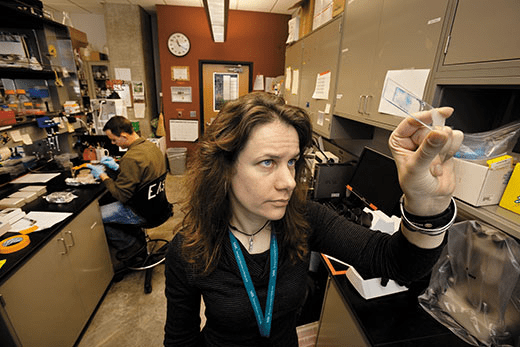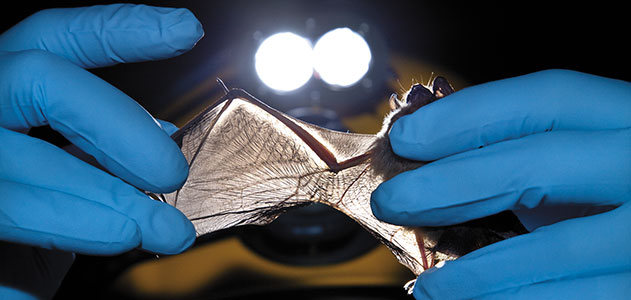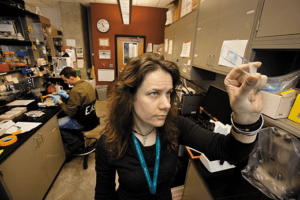
(A longer version of this story was published in Smithsonian Magazine, August 2011.)
What’s Killing the Bats?
Inside the gaping mouth of Mammoth Cave, hibernating bats sleep in permanent twilight, each huddled in its own limestone crevice. Every fall, these big brown bats (Eptesicus fuscus) squeeze their furry bodies into nooks in the cave walls. “Just…let…go…with…your…feet,” coaxes Brooke Slack, a biologist at the Kentucky Department of Fish and Wildlife Resources, as she stands on tiptoes and reaches with gloved hands to pry a bat from the wall.
The bat, visible by the light of her headlamp, lets out a stream of tiny, infuriated shrieks. Slack gently loosens the bat’s claws from the rock and slips the four-inch-long animal into a brown paper bag. On this gray December afternoon, Slack and her colleague, a Northern Kentucky University microbiologist named Hazel Barton, are pressing this unlucky bat into service for its species. Mammoth Cave, the longest known cave in the world, is a front line in the most precipitous decline of North American wildlife in living memory.
Slack collects a half-dozen grumpy bats, then holds each protesting bat while Barton clips samples of hair and swabs faces and wings. “Look at you, with your dirty, dusty little face,” Barton coos, shining her helmet lamp on one screaming bat.

Barton and Slack both know that somewhere in this cave, even on these bats, may lie spores of the fungus Geomyces destructans, which is devastating hibernating bat populations in the Northeastern United States. The fungus appears to be the cause of a disease called white-nose syndrome, which has killed more than a million bats in the past four years, threatening some of the continent’s most abundant bat species with extinction.
So far, despite painstaking searches by Slack and her crew, the fungus has not been found in Kentucky. But the disease has been confirmed in neighboring Virginia, West Virginia and, most worrisome, in a Tennessee cave only 80 miles from Mammoth.
“Oh, look at this,” Slack says to her colleagues. As headlamps turn toward her, Slack stretches out a bat wing, its thin membrane marked by two half-inch tears. They could be from a run-in with an owl. Or they could be a sign that white-nose syndrome has crossed the state line and arrived in Mammoth.
The other bats collected today will be returned to their hibernation perches, but this one will be euthanized for laboratory tests. Reluctantly, Slack and Mike Armstrong from the U.S. Fish and Wildlife Service do the deed with a vial of the chemical isoflourine. “Sorry, little girl,” Armstrong says. One bat sacrificed, in hopes of saving another million of its kind.
Barton, an expert caver, has just spent eight days squeezing her lanky frame through unexplored sections of Lechuguilla Cave, a southern New Mexico cave thought to be the deepest in North America. She grew up in Bristol, England, in a family she describes as “not the slightest bit outdoorsy.” When she was 14, she participated in a required high-school course that included rock-climbing, kayaking, horseback riding and a day of caving. “Everything terrified me but the caving,” she says. “In the cave, I stayed in the back of the group thinking, ‘I love this. This is cool.’”
Barton had also been fascinated by microscopic organisms ever since hearing BBC-TV naturalist David Attenborough marvel about the complexity of life in a single drop of water. After studying biology at the University of the West of England, she moved to the University of Colorado to pursue a PhD in microbiology.
A collaborator, Norman Pace, suggested she study the microscopic life in caves, which scientists knew little about. Barton didn’t want caving—her hobby—to become her job, but eventually she relented and began to plumb caves for signs of microbial activity.
Her experience schooled her in the tenacity of these tiny life-forms. Yet when Barton heard that a bat-killing fungus had managed to spread from caves in New York State all the way to West Virginia in just two years, even she was surprised by its velocity.
“If you sat down and thought, ‘What would I design to kill bats, and how would I design it?’ and you took time to think about the worst possible combination of factors that a pathogen would have, this would be it,” says Barton.
Because G. destructans thrives in cool temperatures, it attacks bats while they hibernate for the winter, when their immune systems are effectively shut down. The fungus may spread from bat to bat, and when the animal colonies disperse in the spring, the fungus may persist in cave sediment, poised to infect the next winter’s arrivals. Bats with white-nose syndrome rouse more frequently from their winter torpor, which causes them to waste precious body fat at the coldest time of the year. The fungus also infects the bats’ delicate wing membranes, eating away at the skin until the wings resemble torn, crumpled tissue paper.
The disease was discovered in early 2007, when New York State biologists found thousands of dead bats in a limestone cave near Albany, many encrusted with a strange white fuzz. During the winters that followed, dead bats piled up in caves throughout the Northeast. The scientists would emerge filthy and saddened, with bat bones—each as thin and flexible as a pine needle—wedged into their boot treads.
By the end of 2008, wildlife-disease researchers had identified the fuzz as a fungus new to North America. Today the fungus has spread to 19 states and 4 Canadian provinces, and infected nine bat species, including the endangered Indiana and gray bats.
“When it first hit, I thought, ‘OK, is there anything we can do to keep it within this cave?’” remembers Hicks. “The next year it was, ‘Is there anything we can do to secure our largest colonies?’ And then the next year it was, ‘Can we keep any of these colonies going?’ Now we’re asking if we can keep these species going.”
G. destructans also infects bats in Europe—but it doesn’t kill them, at least not in large numbers. Researchers don’t know when and how the fungus made its way to North America, but they speculate that it may be so-called “pathogen pollution,” the inadvertent human transport of diseases into new and hospitable habitats.
With G. destructans reaching farther each winter, Barton, Slack and an array of other biologists are racing to understand the fungus in time to contain it.
“Who’s going to live, and who’s going to die?” asks DeeAnn Reeder. “That’s the big thing I think about all the time.”
Reeder, a biology professor at Bucknell University in central Pennsylvania, spends her days studying white-nose syndrome. Some bat species—and some individual bats—are proving more resistant than others. Reeder wants to know why.
After Reeder, an animal physiologist, came to Pennsylvania in 2005, she outfitted her laboratory with a set of climate-controlled chambers. She and her students had just begun to collect data on bat hibernation patterns when white-nose syndrome emerged. Suddenly, biologists all over the continent had questions about how bats behaved during hibernation, and Reeder was one of the only researchers well-positioned to answer them. Like Barton and the rest of the small corps of researchers pursuing the disease, Reeder abruptly reoriented her career to deal with it.
In Kentucky, Barton was also working overtime, sampling skin secretions and hair from bats in caves throughout the state. In her laboratory, she and her students cataloged naturally occurring antifungal compounds produced by bacteria and other fungi. But to test the most promising compounds, she needed something Kentucky didn’t yet have: sick bats.
Last fall, in southeastern Pennsylvania, Barton and several of Reeder’s students donned Tyvek suits and belly-crawled into the depths a limestone mine, where they trapped more than 100 infected bats and confined them in mesh enclosures with aerosolized antifungal compounds. They then left the bats alone to hibernate, hoping that some would survive until spring.
In mid-March, Reeder and her students travel through the rolling Pennsylvania countryside, headed for the limestone mine where bats were caged last fall. At the mouth of the mine, they zip up their Tyvek suits and pick their way through the fallen rocks on the mine floor, the beams of their headlamps cutting through the cool, misty half-dark. Little brown bats are hanging onto the rocks, alone or in twos and threes, their fur glistening with moisture. Here and there, a dead bat lies on the ground.
The crew slips through a narrow horizontal slot on the side of the mine, where more bad news awaits: the mesh cages have been vandalized by raccoons, and the treated bats inside have all either escaped or been eaten. An entire season of data lost—to raccoons! The frustration is palpable.
By the time she returns to the mouth of the mine, Reeder is philosophical. From experiments in the lab this year, she already knows that the treatments they used can’t save bats from white-nose syndrome; at best, they can prolong their lives a little while. Perhaps different compounds, or higher concentrations of the same compounds, might boost survival rates, but those are questions for the next study.
In their search for patterns in the white-nose epidemic, Reeder and her students have found that bats in cooler conditions may have better survival rates. So it’s possible that humans could alter the temperatures in some mines—by changing the shape of entrances to direct airflow, for instance. In Tennessee, conservationists are already planning to build an artificial cave that can be kept fungus-free, and in New Hampshire, biologists are studying bats that hibernate in abandoned World War II-era bunkers, hoping that climate conditions inside will help some bats survive. The National Zoo has attempted to keep endangered Virginia big-eared bats alive in captivity, so far with limited success.
Even if such heroic measures can reduce the toll, many bat species will take generations to recover from white-nose syndrome. “On my worst days, I feel like we’re working our tails off just to document an extinction,” says Reeder. “But somehow in really teasing apart all of this, in really understanding how they die and why, we may find something really important, something we didn’t predict, something that might help.”
This past winter, Brooke Slack and her crew conducted their annual survey of nearly 100 Kentucky caves. The early results were good: It looked as if Kentucky bats had, against the odds, made it through another winter fungus-free. But then white-nose syndrome showed up in southern Ohio, and Slack decided to recheck a few sites near the border.
On April 1, in a limestone cave in southwestern Kentucky, a researcher working with Slack found a little brown bat with white fuzz on its muzzle. They sent it to a laboratory, and a week later Slack got the news she’d anticipated, but dreaded, for the past three years: white-nose syndrome had finally arrived in Kentucky.
Now, Slack’s job is not only to slow the spread of white-nose syndrome, but also to learn as much as she can about the disease as it moves through her state. “There’s a sense of helplessness,” she admits. “But I don’t feel like we can say, ‘Well, we’ve got it, so we give up.’ We’ve got an obligation to move forward.”
© 2011 Michelle Nijhuis




